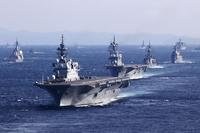On a night in early February, I'm standing on a berm at an Iraqi Army base with Army Sgt. Erik Morrow, watching a $4.5-million M-1A2 tank zero its machine gun in preparation for a mission. Tracers lance into the darkness, striking the target with perfect precision. The tank's accuracy is amazing, even at night. But Morrow just shrugs. Yeah, the A2 is the best tank in the world, hands-down. But, he says, for this war, he'd prefer an older, simpler model that's easier to maintain and starts up faster. These days there's a lot of tension between proponents of the latest uber-lethal whiz-bang weapons and folks who say that modern conflict demands lots of grunts on the ground with simple tools applying smart tactics. Me? I love me some high-tech, but my experience in Iraq tells me the latter party is probably right.
These days there's a lot of tension between proponents of the latest uber-lethal whiz-bang weapons and folks who say that modern conflict demands lots of grunts on the ground with simple tools applying smart tactics. Me? I love me some high-tech, but my experience in Iraq tells me the latter party is probably right.
In two pieces in the latest Sea Power, I explore both ends of the technology spectrum: airborne datalinks on one end and hammers and shovels on the other.
The Seabees piece sums up my position neatly:
Its not a glamorous war the Seabees are fighting. Its a war of hammers, nails, two-by-fours and improvisation in difficult conditions. Despite the occasional incoming mortar round or sniper fire at [Naval Mobile Construction Battalion] 133s detachments, theres not a lot of shooting in their war.
But without the Seabees, the lives of the soldiers and Marines pulling triggers in western Iraq would be a lot more difficult, even impossible. Besides, the United States is trying to bring some civilization to Al Anbar, by force if necessary, and civilization means concrete and security. Success in this desolate province requires concrete plants, runways and huts as much as it does killing bad guys.
--David Axe
High Tech Versus Low
© Copyright 2024 Military.com. All rights reserved. This article may not be republished, rebroadcast, rewritten or otherwise distributed without written permission. To reprint or license this article or any content from Military.com, please submit your request here.








